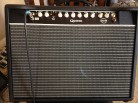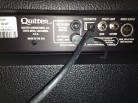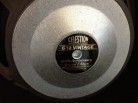First Impressions
I know almost all of you are asking who Quilter is. I know Quilter from years of experience with QSC power amps. Their designs are rock solid and reliable and produce fantastic sound. I've always had a lot of respect for Quilter's power amps so when I found out they had started building guitar amps I had to check them out. While I was researching their amps I learned that Quilter originally started in instrument amps way back in the late 60's with their Quilter Sound Thing. Back in those days there were a lot of companies vying for a musician's dollars so Quilter wisely went into a new market with power amps and formed QSC. Its nice that Pat Quilter has come full circle and decided to work on instrument amplifiers again.
Quilter claims the Aviator is "the world's first Class D that does more than emulate tube tone. It plays like a classic vintage tube amplifier." We've all heard huge claims from manufacturers that their solid state amps sound just like a tube amp. I'm going to break down the sound by channel in the following paragraphs. What I'd like to emphasize is that this is the first solid state amp I've played that reacts like a tube amp and produces true boutique tube amp sound. Roll up the volume on your guitar and suddenly the amp reacts by getting more crunchy just like a tube amp. Roll back your instrument volume and suddenly it cleans up. Seems simple but other solid state amps don't react this way.
The Aviator comes in one large box - inside are the amp, a cover for the amp,and a power cord. The footswitch came in a second smaller box. Looking over the amp I was very impressed with its construction. This amp has a nice vintage look to it. The solid cabinet holds the two Celestion G10 Vintage 10" speakers. I've never played with these speakers before so I was intrigued whether you could go all the way from the grit of a vintage sound to the clean sounds I heard in all the sample videos on Quilter's site and on YouTube. This is an open back design which generally will have less bass and volume projection. The construction of this amp is solid - nice Tolex covering, nice grill material, even incremental notches can be felt on tone adjusting knobs as you rotate them. Volume and gain controls roll nice and smooth. What is cool about this is the amp only weighs 33.8 lbs. I have amp heads that weigh more than that. This makes for a truly portable combo. There is even a card in the box with the name and picture of the person who assembled this amp. In the past I had considered buying a 5150 2x12 combo but at 85 lbs its not really a portable solution.
All Aviator amps are two channel, 100 watt per channel design. Channel 1 has a volume control and tone knob. A single tone knob reminds me very much of Vox's AC30 design. It works well for Vox and even better in this Quilter design. Channel 2's controls go more in depth - gain, bass, mid, treble, and hi cut. The built in reverb which works on both channels has reverb and dwell controls. Most amps feature a single power section with more preamp sections to obtain clean and distorted sounds. The Aviator is unique in that I could play a guitar in the second input (which can be switched between channel 1 and 2) and have a mic plugged into the first channel which only works on channel 1. I've seen other amps that accommodate a mic but how many of those amps can have the mic volume adjusted separately from the guitar sound?
I'm sure your wondering if its loud given its 100 watt rating. Believe me, this thing had absolutely no problems keeping up with my 100 watt tube heads and 4x12 cabinets. In my way of thinking there is loud, really loud, crazy loud, and then stupid loud. The Aviator can easily obtain stupid loud levels - when played with plenty of gain anything above 10 o'clockon the volume on channel 2 is pushing safe listening levels in a practice room. Consider I'm comparing a solid state amp with two 10" speakers in an open back design to a traditional tube amp with a closed back cabinet holding four 12" speakers and I hope you realize how cool this really is. At 12 o'clock this thing is already at performance volume levels - to have so much headroom is impressive from such a small amp.
How Does It Sound?
I have to honestly say that this is the best sounding amp I've heard. Period. I know a lot of people will think I'm crazy given my love for tube amps but let me explain. I first used my 2000 Gibson Les Paul '59 Reissue. On channel one on the amp and the neck pickup I got some tones that just floored me. This is Fender Blackface amp territory. Warm but crisp. No muddy sounds. Very subtle bends and vibrato are clearly heard. If you've spent a lot of time developing your technique you'll be amazed how much more you can hear with this amp. It's not just clear - sometimes channel one on many amps can sound brittle especially with most solid state designs. The Aviator is more like the sound a bowed string instrument has - warm but change how you attack the strings and the difference is instantly obvious. It can be bell like but then roll up your volume slowly and change your attack and you can twang or even go into crunch. With both the neck and bridge pickups selected I got something very lyrical and expressive. In this configuration very slight changes of the volume controls and tone knobs made huge changes in the sound coming from the amp. Generally I don't like playing the bridge pickup by itself on most amps when using a clean channel. I find it too bright and brittle. With the Aviator I found that I could easily smooth out this brittle sound by rolling the volume back a small amount. This gave me new versatility I've never had with this guitar. I next switched to a Strat. In position 2 and 4 of the pickups I got some fantastic jazz tones. Better than I've ever gotten with any other amp. I've used this guitar less and less over the years except when practicing without an amp. Now I find myself finding new tones I never had before and wanting to use this guitar more and more. With a Tele I could easily twang or find jazz tones.
As happy as I was with channel 1 I found myself in love with channel 2. At low gain settings I found the tone controls work extremely well. Again we are in Fender territory here. A small adjustment of bass or mids is immediately perceivable in the output sound. One thing on both channels that is just like a tube amp is that at low guitar volume settings the sound is very clean - turn up the volume on the guitar and the sound reacts just like the preamp section of a tube amp. Grit increases as well as overtones. On channel 2 as you pass the 12 o'clock position on the gain knob you are in classic rock territory. Every video I saw online only went this far so I wasn't sure how much gain was really possible. Turns out there is a lot more gain on tap to be had - all the way to hard rock and heavy metal country. Why no one else decided to demonstrate this is beyond me as this makes this amp that much more versatile. This amp at high gain settings is every bit as good as any boutique amp I've tried. There, I've said it and stuck my neck way out with that but I can't emphasize enough how good channel two can sound from very clean settings all the way to full on rock. Use the high cut knob and you can control what type of sound you have - classic fuzzy tones to clean modern lead.
I think the decision to use those Celestion 10" speakers was an excellent one. They hit rock tones so easily yet sound great when playing clean. With the volume at 12 o'clock and both pickups on full volume on channel 1 the speakers have slight breakup - something like vintage Celestion Greenbacks. Before you are absolutely sure how a speaker will sound you really should give them about 20 hours of break in. After about two weeks I found the sound getting better and better. This is something I like about these Celestion speakers - they get better with age.
Keep the amp's volume low and hook up a PA to the Direct Out (line out) and you are in business. No PA system? No problem, this thing has plenty of power to keep up with the instruments in a band. I've read over and over that this amp outputs 200 watts. Since channel 1 and channel 2 can be played simultaneously this is not hype. One input is labeled channel one and two which is for guitar input. I found that I could use the other input for mic but here's something even better - for someone else playing an electric acoustic. Since both channels can be used simultaneously and both have their own volume control we found we could get two musicians on one amp and it sounded great. Remember channel two can produce excellent clean tones with the gain set low.
The reverb on this amp is foot switchable. With only two control knobs for reverb you'd expect this to be a so-so add on. This reverb is fully integrated into the total sound. The reverb control sounds very good throughout all its settings and the dwell can go from a natural sound all the way to a very spacey sound. This reminded me of an old Fender Twin Reverb I played years ago which could obtain the most reverb I've ever heard. The likelihood of going full bore on the reverb isn't high but that leads us to the next section - sounds that can be made with effects pedals. I'm guessing that Pat Quilter used the tone of vintage Fender amps as his target for clean tones. The distortion this amp can make is impressive but very natural sounding. Not that brittle hard sound you expect from a solid state amp. I'm guessing that a British amp like a Marshall JCM 800 was the goal for the sound this amp produces on full bore distortion.
How Does It Work With Pedals?
This is one area you should be careful with the Aviator. I found that the amp is so sensitive to input that any noisy pedal instantly diminishes the tone quality. Overdrive pedals are a dream with this amp - it reacts just like a tube amp. Kick in the overdrive and suddenly you have overtones and grit that sound exactly like a tube amp. I found the distortion in the amp was much better than I could achieve with any distortion pedal I hooked up to the amp. Actually I found that pedals can be handy but unless you are using something like a tremolo or delay to radically change the sound your better off staying clear of too many pedals. This amp reacts so well that often you find you go way past the sound you are used to getting from other amps.
This gets to the point that a really good amp doesn't need a lot of pedals. Time delay effects are a good idea and this amp has an effects loop if you want to place them there. Really good amps don't need distortion pedals - Clapton, Hendrix, Van Halen, etc all got their sound from only their amps - very little effects. This is a case where too many ingredients can ruin the soup - try to keep it simple and enjoy the great natural tone the amp is creating. Add a flanger and you get great sound but I would not try to add lots of effects simultaneously. The built in reverb gives you lots of flexibility - mild to wild. I found that overdrives, delays, compression, and wah type effects were great with this amp. I didn't like distortion pedals with it and depending on the chorus pedal it could actually ruin the beautiful tones of the amp. Pedals you thought sounded great suddenly get reevaluated with this amp.
Conclusions
I've already stated that the Aviator is the best sounding amp I've ever heard. I've heard and tried lots of amps over almost 30 years. The clear channel (channel one) is simple to operate but gives very expressive sounds and can go from bell like sounds all the way to twangy and crunchy sounds. Channel two on this amp is just amazing. You can mimic the tones of channel one or go all the way into heavy metal country. This amp isn't made for guys that play with lots of drop tuning and screamo lyrics - but that's OK since that's only 1% of the market. On both channels you'll find that this amp is so responsive to changes in attack and style. Would I change anything on this amp? Surprisingly, I'd be afraid to change anything. If I had to change anything it would be to add a mix control for the effects loop to control how much of the original and effects loop sound come through. That said, I like the simple layout of this amplifier. This amp reminds me so much of some of the best vintage amps I've tried - both American and British. Those amps had great sound without needing a manual to operate them. But this amp bows to modern improvements - a great effects loop and a direct out that lets you use the venue's PA system rather than trying to have a volume war with the other musicians.
Quilter has a lot of history with PA amps and it shows with the high quality build of this unit. Overall its very flexible and I found it light and comfortable to take to any gig. This is much easier than moving a full cabinet and head plus a full pedal board. I found I could get away with just an overdrive pedal thrown in my guitar case. I don't hesitate to recommend the Aviator - I haven't tried the single 8" or single 12" model and would really like to hear them. I chose the twin 10" model as I thought it would have more projection and headroom. I was absolutely right when comparing to other combos I've used. I hope Quilter gets into more music stores as I think people should do a side by side comparison with some popular tube amps to see what a great amp this is. Pat Quilter definitely has built a tone machine - something a tone chaser like me can really appreciate. You shouldn't have to worry what's in the amp - you should worry whether you are getting the sound you want and this amp delivers that in spades. I'm going to miss this amp when I send it back - more than any amp I've tried.














